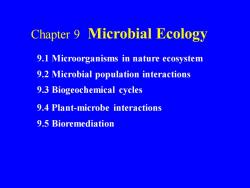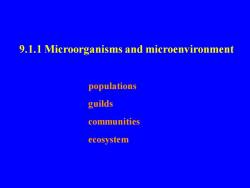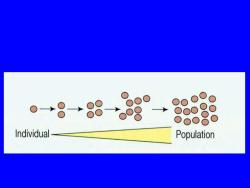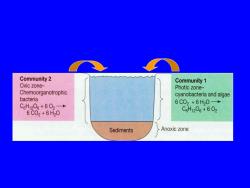华中农业大学:《食品微生物学》课程PPT教学课件(Food Microorganism)Chapter 9 Microbial Ecology

Chapter 9 Microbial Ecology Microbial ecology = ? Environmental microbiology The term microbial ecology is now used in a general way to describe the presence and distributions of microorganisms. Microbial ecology is the the study of the behavior and activities of microorganisms in their natural environments
Chapter 9 Microbial Ecology Microbial ecology = ? Environmental microbiology The term microbial ecology is now used in a general way to describe the presence and distributions of microorganisms. Microbial ecology is the the study of the behavior and activities of microorganisms in their natural environments

Environmental microbiology, in comparison, relates primarily to all- over microbial processes that occur in a soil, water or food, as examples. It is not concerned with the particular microenvironment where the microorganisms actually are functioning, but with the broader-scale effects of microbial presence and activities
Environmental microbiology, in comparison, relates primarily to all- over microbial processes that occur in a soil, water or food, as examples. It is not concerned with the particular microenvironment where the microorganisms actually are functioning, but with the broader-scale effects of microbial presence and activities

9.1 Microorganisms in nature ecosystem 9.2 Microbial population interactions 9.3 Biogeochemical cycles 9.4 Plant-microbe interactions 9.5 Bioremediation Chapter 9 Microbial Ecology
9.1 Microorganisms in nature ecosystem 9.2 Microbial population interactions 9.3 Biogeochemical cycles 9.4 Plant-microbe interactions 9.5 Bioremediation Chapter 9 Microbial Ecology

9.1 Microorganisms in nature ecosystem 1. Microorganisms and microenvironment 2. Terrestrial Environments 3. Freshwater Environments 4. Marine Environments
9.1 Microorganisms in nature ecosystem 1. Microorganisms and microenvironment 2. Terrestrial Environments 3. Freshwater Environments 4. Marine Environments

9.1.1 Microorganisms and microenvironment populations guilds communities ecosystem
9.1.1 Microorganisms and microenvironment populations guilds communities ecosystem

Metabolically related populations constitute groupings called guilds. Sets of guilds conducting complementary physiological processes interact to form microbial communities. In a microbial ecosystem individual cells grow to form populations
Metabolically related populations constitute groupings called guilds. Sets of guilds conducting complementary physiological processes interact to form microbial communities. In a microbial ecosystem individual cells grow to form populations

Individual Population

Community 2 Community 1 Oxic zone- Photic zone- Chemoorganotrophic cyanobacteria and algae bacteria C6H1206+602一→ 6C02+6H0→ 6C02+6H20 C6H1206+602 Sediments Anoxic zone

Community 3
Community 3

Microbial communities then interact with communities of macroorganisms to define the entire ecosystem
Microbial communities then interact with communities of macroorganisms to define the entire ecosystem
按次数下载不扣除下载券;
注册用户24小时内重复下载只扣除一次;
顺序:VIP每日次数-->可用次数-->下载券;
- 华中农业大学:《食品微生物学》课程PPT教学课件(Food Microorganism)Chapter 8 Bacterial genetics.ppt
- 华中农业大学:《食品微生物学》课程PPT教学课件(Food Microorganism)Chapter 7 Microbial Growth and Growth control.ppt
- 华中农业大学:《食品微生物学》课程PPT教学课件(Food Microorganism)Chapter 6 Microbial Growth and Metabolism.ppt
- 华中农业大学:《食品微生物学》课程PPT教学课件(Food Microorganism)Chapter 5 Viruses.ppt
- 华中农业大学:《食品微生物学》课程PPT教学课件(Food Microorganism)Chapter 4 Eukaryotic Microorganisms.ppt
- 华中农业大学:《食品微生物学》课程PPT教学课件(Food Microorganism)Chapter 3 The Prokaryotes.ppt
- 华中农业大学:《食品微生物学》课程PPT教学课件(Food Microorganism)Chapter 2 Cell Biology.ppt
- 华中农业大学:《食品微生物学》课程PPT教学课件(Food Microorganism)Chapter 1 Biology of microorganism.ppt
- 桂林医学院:《生物化学与分子生物学》课程教学资源(PPT课件)第九章 代谢调节.ppt
- 桂林医学院:《生物化学与分子生物学》课程教学资源(PPT课件)第八章 核苷酸代谢.ppt
- 桂林医学院:《生物化学与分子生物学》课程教学资源(PPT课件)第七章 氨基酸代谢.ppt
- 桂林医学院:《生物化学与分子生物学》课程教学资源(PPT课件)第六章 生物氧化.ppt
- 桂林医学院:《生物化学与分子生物学》课程教学资源(PPT课件)第五章 脂类代谢.ppt
- 桂林医学院:《生物化学与分子生物学》课程教学资源(PPT课件)第四章 糖代谢.ppt
- 桂林医学院:《生物化学与分子生物学》课程教学资源(PPT课件)第三章 酶化学.ppt
- 桂林医学院:《生物化学与分子生物学》课程教学资源(PPT课件)第二章 核酸的结构与功能.ppt
- 桂林医学院:《生物化学与分子生物学》课程教学资源(PPT课件)第二十三章 基因组学.ppt
- 桂林医学院:《生物化学与分子生物学》课程教学资源(PPT课件)第二十二章 常用分子生物学技术的原理及其应用.ppt
- 桂林医学院:《生物化学与分子生物学》课程教学资源(PPT课件)第二十一章 基因诊断与基因治疗.ppt
- 桂林医学院:《生物化学与分子生物学》课程教学资源(PPT课件)第二十章 癌基因与抑癌基因.ppt
- 河北农业大学:《食品微生物学》课程教学资源(PPT课件)第一章 绪论(任课教师:贾英民).ppt
- 河北农业大学:《食品微生物学》课程教学资源(PPT课件)第二章 微生物主要类群的形态、结构和功能.ppt
- 河北农业大学:《食品微生物学》课程教学资源(PPT课件)第三章 微生物的营养.ppt
- 河北农业大学:《食品微生物学》课程教学资源(PPT课件)第四章 微生物的代谢.ppt
- 河北农业大学:《食品微生物学》课程教学资源(PPT课件)第五章 微生物的生长及其影响因素.ppt
- 河北农业大学:《食品微生物学》课程教学资源(PPT课件)第六章 微生物的遗传变异与菌种选育.ppt
- 河北农业大学:《食品微生物学》课程教学资源(PPT课件)第七章 发酵食品微生物.ppt
- 河北农业大学:《食品微生物学》课程教学资源(PPT课件)第八章 微生物与食品腐败变质.ppt
- 河北农业大学:《食品微生物学》课程教学资源(PPT课件)第九章 食品卫生微生物.ppt
- 广东轻工职业技术学院:《微生物学》课程教学课件(PPT讲稿)第一章 绪论(主讲:石琳).ppt
- 广东轻工职业技术学院:《微生物学》课程教学课件(PPT讲稿)第二章 微生物类群及形态结构.ppt
- 广东轻工职业技术学院:《微生物学》课程教学课件(PPT讲稿)第三章 微生物的营养.ppt
- 广东轻工职业技术学院:《微生物学》课程教学课件(PPT讲稿)第四章 微生物的代谢.ppt
- 广东轻工职业技术学院:《微生物学》课程教学课件(PPT讲稿)第五章 微生物的生长和纯培养.ppt
- 广东轻工职业技术学院:《微生物学》课程教学课件(PPT讲稿)第六章 理化因素对微生物的影响.ppt
- 广东轻工职业技术学院:《微生物学》课程教学课件(PPT讲稿)第七章 微生物的遗传和变异.ppt
- 广东轻工职业技术学院:《微生物学》课程教学课件(PPT讲稿)第八章 菌种保藏.ppt
- 广东轻工职业技术学院:《微生物学》课程教学课件(PPT讲稿)第九章 微生物类群及形态结构.ppt
- 河南科技学院:《分子生物学》课程教学资源(试卷习题)分子生物学试题及答案1.doc
- 河南科技学院:《分子生物学》课程教学课件(PPT讲稿)第一讲 序论(主讲:常景玲).ppt
